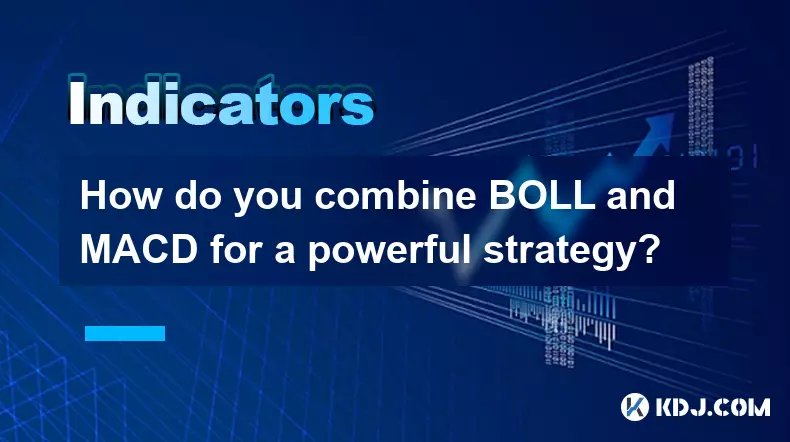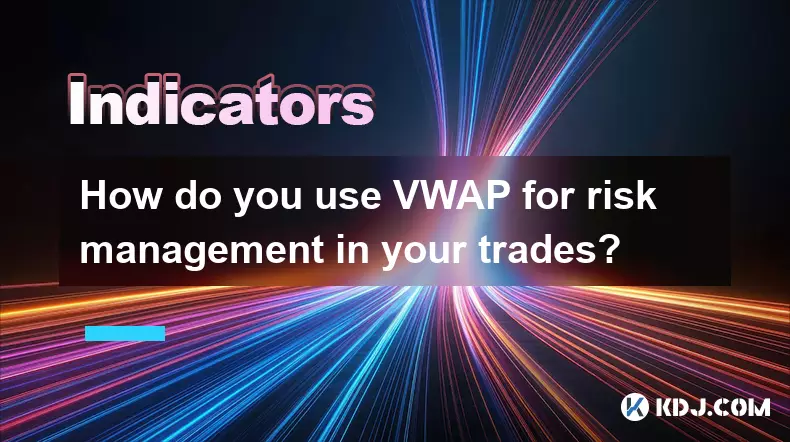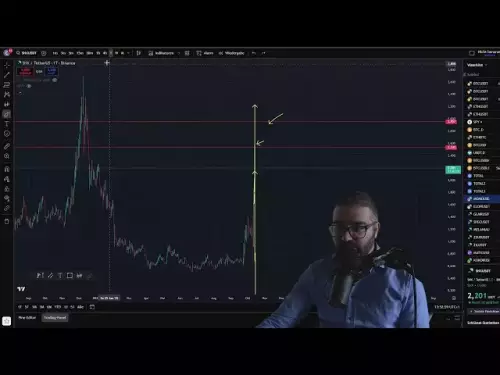-
 bitcoin
bitcoin $115692.075601 USD
5.13% -
 ethereum
ethereum $4162.931611 USD
11.68% -
 bnb
bnb $1310.063287 USD
17.56% -
 tether
tether $1.000983 USD
0.00% -
 xrp
xrp $2.534505 USD
8.16% -
 solana
solana $198.235737 USD
13.49% -
 usd-coin
usd-coin $1.000236 USD
0.02% -
 dogecoin
dogecoin $0.207352 USD
12.89% -
 tron
tron $0.323043 USD
3.62% -
 cardano
cardano $0.701559 USD
11.88% -
 hyperliquid
hyperliquid $39.924597 USD
8.30% -
 chainlink
chainlink $18.934457 USD
11.56% -
 ethena-usde
ethena-usde $1.000552 USD
0.02% -
 stellar
stellar $0.340575 USD
7.05% -
 bitcoin-cash
bitcoin-cash $545.011757 USD
8.86%
How do you combine BOLL and MACD for a powerful strategy?
Combining BOLL and MACD enhances trading accuracy by filtering false signals—BOLL identifies volatility and potential reversals, while MACD confirms momentum shifts, improving entry timing and risk management in both trending and ranging markets.
Oct 10, 2025 at 08:01 am

Understanding the Synergy Between BOLL and MACD
1. The Bollinger Bands (BOLL) indicator measures volatility and identifies potential overbought or oversold conditions by plotting two standard deviations away from a simple moving average. When prices touch or breach the upper or lower bands, it often signals strong momentum or a possible reversal. Traders use this to anticipate price exhaustion or breakout opportunities.
2. The Moving Average Convergence Divergence (MACD) reveals changes in momentum by comparing short-term and long-term exponential moving averages. The MACD line, signal line, and histogram provide visual cues about trend strength and direction. A crossover between the MACD and signal lines can indicate entry or exit points.
3. Combining both indicators allows traders to filter out false signals. For example, a price touching the upper Bollinger Band may suggest overbought conditions, but without confirmation from MACD, the move could still have room to run. When MACD begins to decline or shows bearish divergence, it strengthens the case for a reversal.
4. Volatility contraction, seen when Bollinger Bands narrow, often precedes sharp price movements. If this squeeze occurs while MACD is flat or coiling, it hints at accumulating energy. A breakout accompanied by a strong MACD move in the same direction increases the probability of a sustained trend.
5. This dual-indicator approach helps distinguish between genuine breakouts and fakeouts. A breakout above the upper band with rising MACD confirms bullish strength. Conversely, a breakout without MACD support may be a trap, leading to a swift reversion to the mean.
Entry Signals Using BOLL and MACD Together
1. A buy signal emerges when price touches the lower Bollinger Band and starts to rise, coinciding with the MACD line crossing above the signal line. This confluence suggests that selling pressure is weakening and bullish momentum is building.
2. In a trending market, pullbacks to the middle Bollinger Band (20-period SMA) become significant. If the price bounces off this level and MACD turns upward from near-zero territory, it validates continuation of the trend.
3. Bullish divergence on MACD—where price makes a lower low but MACD forms a higher low—combined with a touch of the lower band, highlights potential reversal zones. Such setups are especially reliable in ranging markets.
4. For short entries, price contacting the upper band alongside a bearish MACD crossover provides a high-probability setup. The tighter the bands before the signal, the stronger the potential downward move.
5. Confirmation is key. Waiting for the candle to close beyond the band with matching MACD movement reduces whipsaw risk. Entry after confirmation avoids premature positioning during volatile swings.
Risk Management and Trade Execution
1. Stop-loss placement depends on the context. For longs triggered at the lower band, placing stops just below the recent swing low protects against breakdowns. For shorts at the upper band, stops go slightly above the latest peak.
2. Position sizing should account for volatility. Wider Bollinger Bands imply larger price swings; thus, smaller position sizes help manage exposure. During squeezes, even small moves can trigger large reactions, warranting caution.
3. Take-profit levels can align with the opposite band. A long trade initiated at the lower band might target the upper band, especially if MACD shows signs of topping out. Scaling out partial profits near mid-band improves risk-reward balance.
4. Monitoring MACD histogram contraction helps identify loss of momentum. If the bars shrink while price approaches the target zone, it suggests weakening force, prompting early exits or tightening stops.
5. Avoid trading against the dominant trend even if BOLL and MACD suggest counter-trend signals. Aligning with higher timeframe direction increases win rates significantly.
Adapting the Strategy to Crypto Markets
1. Cryptocurrencies exhibit extreme volatility, causing frequent Bollinger Band breaches. Rather than treating every touch as a reversal signal, traders must assess whether the asset is in a strong trend or consolidation phase.
2. In bull runs, price often rides the upper band, making lower band reversals rare. Here, MACD staying above zero and pulling back toward the signal line offers better long-entry zones than waiting for lower band contact.
3. Altcoins tend to experience rapid pumps and dumps. A sudden spike through the upper band with an explosive MACD surge often marks exhaustion. These parabolic moves followed by MACD rollover signal imminent corrections.
4. Stablecoins and less volatile digital assets behave more like traditional range-bound instruments. BOLL-MACD combinations work effectively here, identifying clear mean-reversion points within defined channels.
5. Timeframe alignment enhances accuracy. Using daily charts to determine trend direction and 4-hour or 1-hour charts for precise entries ensures consistency across market layers.
Frequently Asked Questions
What does a MACD crossover during a Bollinger Band squeeze indicate?It suggests buildup of momentum preceding a breakout. A MACD cross upward during a squeeze hints at bullish resolution; a downward cross implies bearish pressure is mounting.
Can BOLL and MACD be used on intraday timeframes in crypto trading?Yes, especially on 15-minute to 1-hour charts. However, due to noise and flash crashes, additional filters like volume or order book depth improve reliability.
How do you handle conflicting signals between BOLL and MACD?When BOLL suggests a reversal but MACD shows strengthening momentum, defer action. Wait for price to confirm the MACD direction or for BOLL to reflect renewed volatility before entering.
Is this strategy effective during low-volume periods?Performance declines during low liquidity, such as weekends or holiday seasons. Reduced participation leads to erratic band movements and delayed MACD responses, increasing false signals.
Disclaimer:info@kdj.com
The information provided is not trading advice. kdj.com does not assume any responsibility for any investments made based on the information provided in this article. Cryptocurrencies are highly volatile and it is highly recommended that you invest with caution after thorough research!
If you believe that the content used on this website infringes your copyright, please contact us immediately (info@kdj.com) and we will delete it promptly.
- XRP Price Prediction: Weekend Rollercoaster or Rally?
- 2025-10-12 08:45:16
- Bittensor (TAO): Super Bullish Signals Point to Potential 2x Rally
- 2025-10-11 10:25:12
- Silver Price Correction: Navigating the Dip & Identifying Key SEO Keywords
- 2025-10-11 10:25:12
- Decoding Crypto Trends: Bittensor's Bull Run, Cardano's Dip, and LivLive's Presale Buzz in 'Uptober 2025'
- 2025-10-12 08:45:16
- MoonBull: The Crypto Meme Coin Promising 1000x Gains?
- 2025-10-11 10:30:01
- Crypto Payroll Revolution: Stablecoins, Altcoins, and the Future of Salary Payments
- 2025-10-11 10:30:01
Related knowledge

What's the main difference between VWAP and TWAP?
Oct 12,2025 at 11:54am
Understanding VWAP and Its Role in Crypto Trading1. Volume Weighted Average Price (VWAP) is a trading benchmark that calculates the average price of a...

How do you identify exhaustion moves using VWAP and its bands?
Oct 12,2025 at 08:00am
Understanding the Role of Decentralized Exchanges in Crypto Trading1. Decentralized exchanges (DEXs) operate without a central authority, allowing use...

How do you use VWAP to scale in and out of positions?
Oct 14,2025 at 02:19am
Understanding VWAP as a Dynamic Benchmark1. The Volume Weighted Average Price (VWAP) is not just an indicator—it functions as a dynamic benchmark that...

What are the main advantages of using VWAP over EMA?
Oct 11,2025 at 02:18am
Main Advantages of Using VWAP Over EMA1. Volume-Weighted Average Price (VWAP) incorporates trading volume into its calculation, offering a more accura...

How do you use VWAP on different chart types like Heikin Ashi?
Oct 11,2025 at 05:01pm
Understanding VWAP in the Context of Heikin Ashi Charts1. The Volume Weighted Average Price (VWAP) is a powerful analytical tool commonly used by trad...

How do you use VWAP for risk management in your trades?
Oct 11,2025 at 02:54am
Understanding VWAP as a Dynamic Benchmark1. The Volume Weighted Average Price (VWAP) serves as a crucial reference point in intraday trading by reflec...

What's the main difference between VWAP and TWAP?
Oct 12,2025 at 11:54am
Understanding VWAP and Its Role in Crypto Trading1. Volume Weighted Average Price (VWAP) is a trading benchmark that calculates the average price of a...

How do you identify exhaustion moves using VWAP and its bands?
Oct 12,2025 at 08:00am
Understanding the Role of Decentralized Exchanges in Crypto Trading1. Decentralized exchanges (DEXs) operate without a central authority, allowing use...

How do you use VWAP to scale in and out of positions?
Oct 14,2025 at 02:19am
Understanding VWAP as a Dynamic Benchmark1. The Volume Weighted Average Price (VWAP) is not just an indicator—it functions as a dynamic benchmark that...

What are the main advantages of using VWAP over EMA?
Oct 11,2025 at 02:18am
Main Advantages of Using VWAP Over EMA1. Volume-Weighted Average Price (VWAP) incorporates trading volume into its calculation, offering a more accura...

How do you use VWAP on different chart types like Heikin Ashi?
Oct 11,2025 at 05:01pm
Understanding VWAP in the Context of Heikin Ashi Charts1. The Volume Weighted Average Price (VWAP) is a powerful analytical tool commonly used by trad...

How do you use VWAP for risk management in your trades?
Oct 11,2025 at 02:54am
Understanding VWAP as a Dynamic Benchmark1. The Volume Weighted Average Price (VWAP) serves as a crucial reference point in intraday trading by reflec...
See all articles










































































